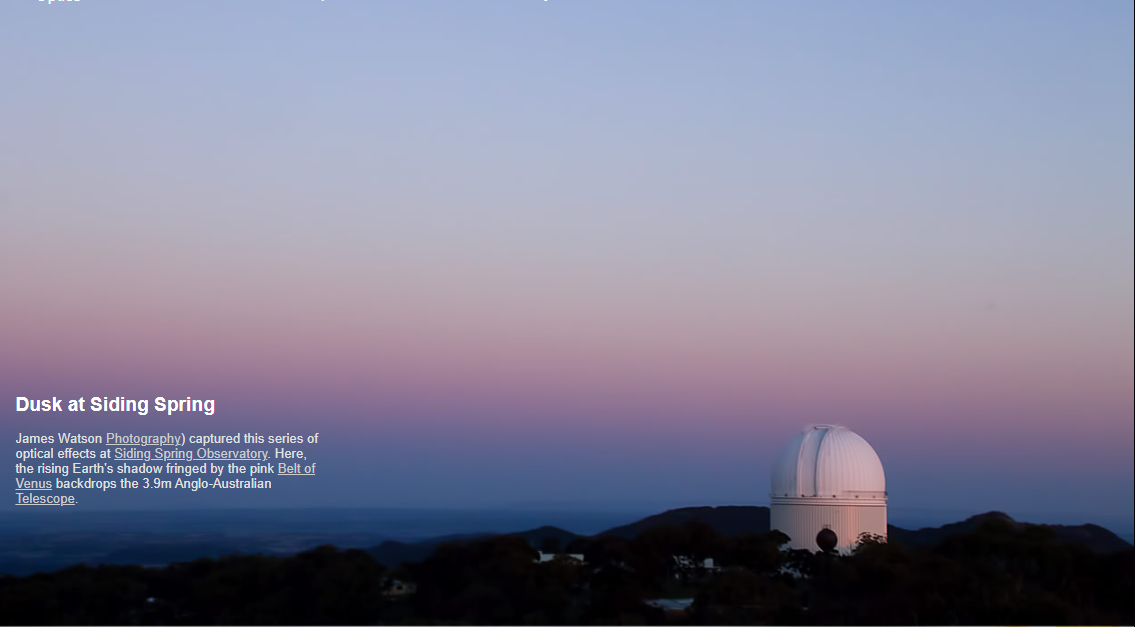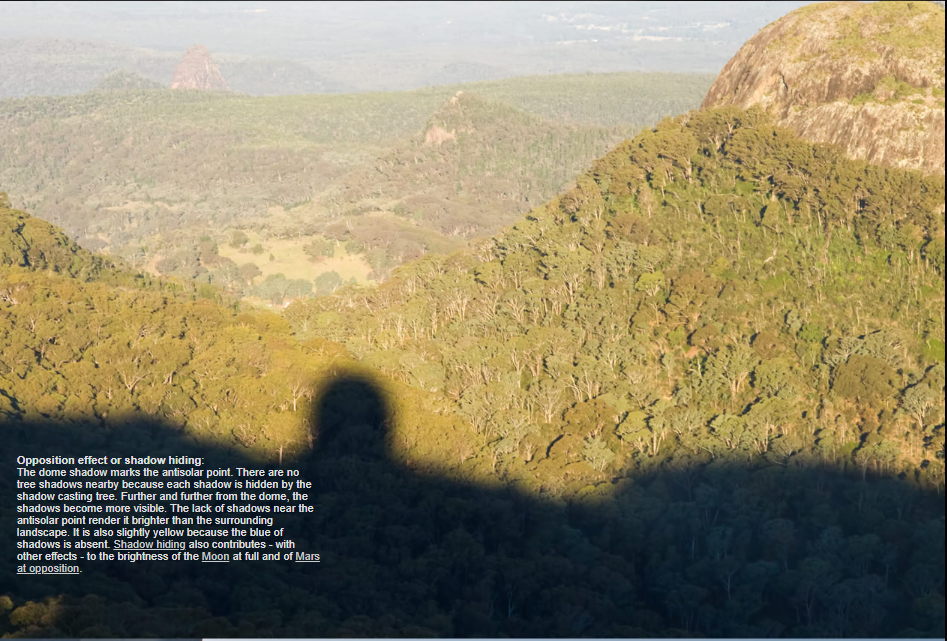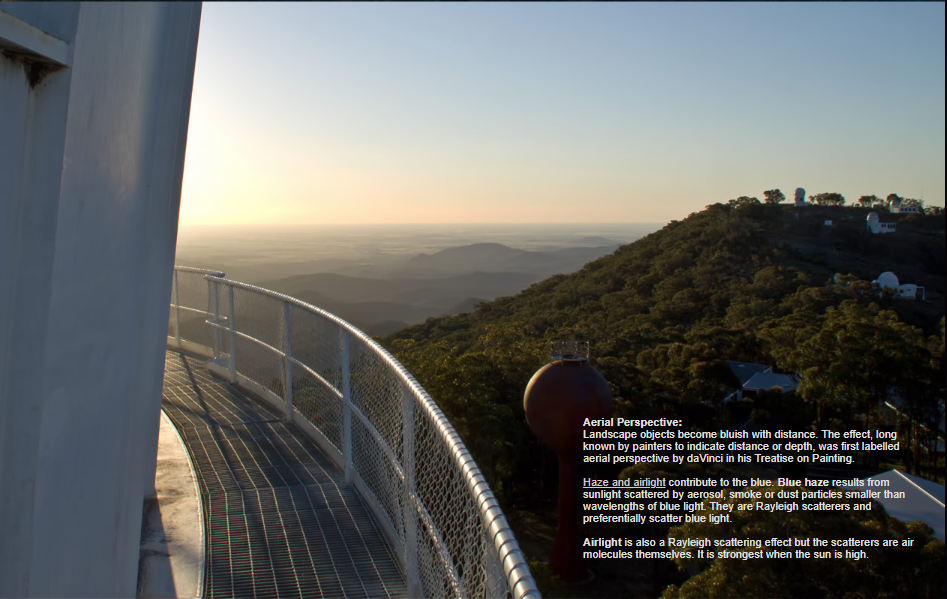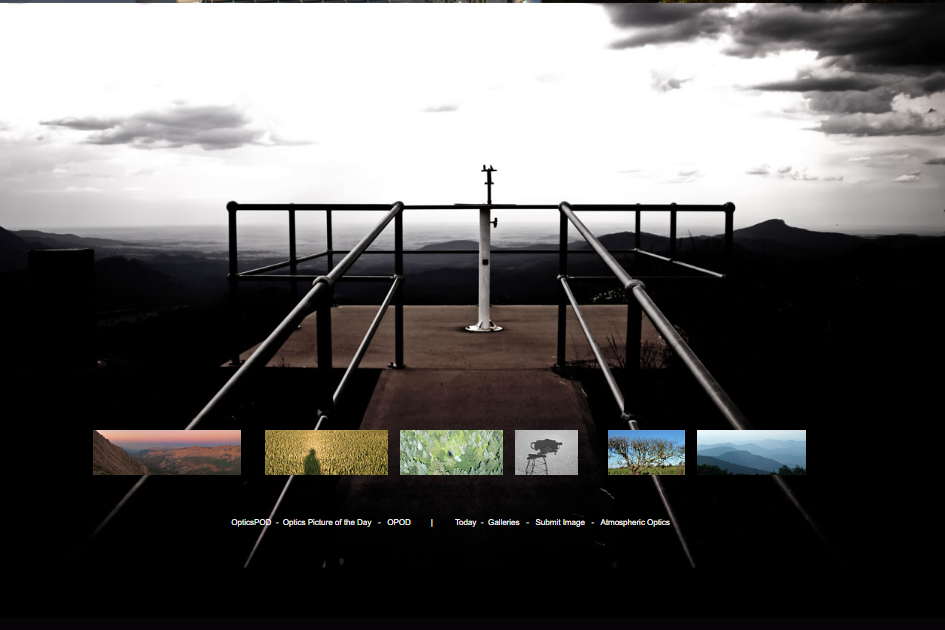OPOD - Siding Spring
OPOD - Siding Spring: A Spectacular Display of Atmospheric Optics
Siding Spring Observatory, nestled in the picturesque countryside, offers a captivating view of various atmospheric optical phenomena. This article explores the enchanting effects captured by James Watson Photography, providing a more detailed and thorough understanding of these phenomena.
Dusk at Siding Spring: A Painter's Dream
As the sun dips below the horizon, the sky transforms into a canvas of vibrant colors at Siding Spring Observatory. In one captivating image, James Watson Photography captures the rising Earth's shadow, delicately fringed by the pink Belt of Venus, forming a breathtaking backdrop to the 3.9m Anglo-Australian Telescope. This ethereal scene epitomizes the beauty of atmospheric optics.
Opposition Effect and Shadow Hiding: Unveiling Nature's Illusions
The dome shadow, marking the antisolar point, creates an intriguing optical illusion known as the opposition effect or shadow hiding. Near the dome, tree shadows remain concealed by the shadow casting tree itself. However, as one moves further away from the dome, these shadows gradually become visible. This phenomenon contributes, among other effects, to the heightened brightness of celestial bodies such as the Moon at full and Mars at opposition.
Aerial Perspective: The Blue Haze of Distance
Landscape artists have long recognized that objects appear bluish as they recede into the distance. Leonardo da Vinci aptly termed this effect "aerial perspective" in his Treatise on Painting. The blue hue results from sunlight being scattered by tiny aerosol, smoke, or dust particles smaller than the wavelengths of blue light. These Rayleigh scatterers preferentially scatter blue light, contributing to the bluish appearance of distant objects.
Haze and Airlight: The Mysterious Blue
Haze and airlight play significant roles in creating the mesmerizing blue hues observed in the atmosphere. Blue haze is formed when sunlight scatters off aerosol, smoke, or dust particles that are smaller than the wavelengths of blue light. These particles, known as Rayleigh scatterers, scatter blue light more effectively, resulting in the characteristic blue haze.
On the other hand, airlight is a Rayleigh scattering effect caused by the scattering of sunlight by air molecules themselves. This phenomenon is most pronounced when the sun is high in the sky. The combination of blue haze and airlight produces the stunning blue tinge observed in distant landscapes.
A Deeper Dive into Atmospheric Optics
Exploring atmospheric optics at Siding Spring Observatory offers an opportunity to delve deeper into the intriguing interplay between light and the atmosphere. Some additional concepts to consider include:
- Scattering: The process by which light is redirected from its original path by interacting with particles or molecules in the atmosphere.
- Rayleigh Scattering: The preferential scattering of shorter wavelengths of light, such as blue and violet, by small particles or molecules.
- Color Perception: How our eyes perceive and interpret different colors under various atmospheric conditions.
- Sunset and Sunrise Phenomena: The array of captivating optical effects that occur during these transitional periods, including the green flash, crepuscular rays, and the Belt of Venus.
Conclusion
Siding Spring Observatory provides a front-row seat to witness the captivating world of atmospheric optics. From the enchanting dusk scenes with the Earth's shadow and Belt of Venus to the intriguing opposition effect and the bluish hues created by aerial perspective, this observatory offers a unique glimpse into the wonders of our atmosphere. By exploring these phenomena, we gain a deeper appreciation for the interplay between light, particles, and molecules that shape our visual experiences. So, next time you find yourself gazing at the sky, remember that there is a whole world of optical wonders waiting to be discovered.

Dusk at Siding Spring
James Watson Photography) captured this series of optical effects at Siding Spring Observatory. Here, the rising Earth's shadow fringed by the pink Belt of Venus backdrops the 3.9m Anglo-Australian Telescope.

Opposition effect or shadow hiding:
The dome shadow marks the antisolar point. There are no tree shadows nearby because each shadow is hidden by the shadow casting tree. Further and further from the dome, the shadows become more visible. The lack of shadows near the antisolar point render it brighter than the surrounding landscape. It is also slightly yellow because the blue of shadows is absent. Shadow hiding also contributes - with other effects - to the brightness of the Moon at full and of Mars at opposition.

Aerial Perspective:
Landscape objects become bluish with distance. The effect, long known by painters to indicate distance or depth, was first labelled aerial perspective by daVinci in his Treatise on Painting.
Haze and airlight contribute to the blue. Blue haze results from sunlight scattered by aerosol, smoke or dust particles smaller than wavelengths of blue light. They are Rayleigh scatterers and preferentially scatter blue light.
Airlight is also a Rayleigh scattering effect but the scatterers are air molecules themselves. It is strongest when the sun is high.

Note: this article has been automatically converted from the old site and may not appear as intended. You can find the original article here.
Reference Atmospheric Optics
If you use any of the definitions, information, or data presented on Atmospheric Optics, please copy the link or reference below to properly credit us as the reference source. Thank you!
-
<a href="https://atoptics.co.uk/blog/opod-siding-spring/">OPOD - Siding Spring</a>
-
"OPOD - Siding Spring". Atmospheric Optics. Accessed on April 20, 2024. https://atoptics.co.uk/blog/opod-siding-spring/.
-
"OPOD - Siding Spring". Atmospheric Optics, https://atoptics.co.uk/blog/opod-siding-spring/. Accessed 20 April, 2024
-
OPOD - Siding Spring. Atmospheric Optics. Retrieved from https://atoptics.co.uk/blog/opod-siding-spring/.